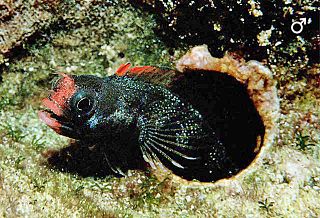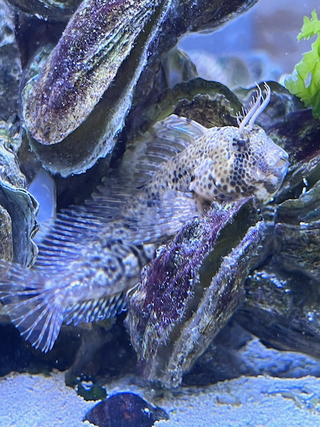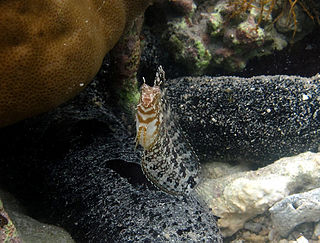
The blennioid family Chaenopsidae includes the pike-blennies, tube-blennies, and flagblennies, all percomorph marine fish in the order Blenniiformes. The family is strictly tropical, ranging from North to South America. Members are also present in waters off Japan, Taiwan and Korea. Fourteen genera and 90 species are represented, the largest being the sarcastic fringehead, Neoclinus blanchardi, at 30 cm (12 in) in length; most are much smaller, and the group includes perhaps the smallest of all vertebrates, Acanthemblemaria paula, measuring just 1.3 cm (0.51 in) long as an adult.

Malacoctenus is a genus of labrisomid blennies native to the eastern Pacific Ocean and the Atlantic Ocean.

Salarias is a genus of combtooth blennies found in the Indian and Pacific oceans.

Acanthemblemaria is a genus of chaenopsid blennies native to the Atlantic and Pacific Oceans.

Cirripectes is a large genus of combtooth blennies found throughout the Pacific and Indian oceans. Cirripectes biconvexus, an otolith based fossil species from the Burdigalian (Miocene) of southwestern India is probably the earliest record of this genus.

Hypleurochilus is a genus of combtooth blennies found throughout the Atlantic Ocean.

Hypsoblennius is a genus of combtooth blennies found in the Pacific and Atlantic Oceans.

Meiacanthus is a genus of combtooth blennies found in the western Pacific and Indian oceans. Many species in this genus make their way into the aquarium trade and several are venomous. The genus name Meiacanthus is derived from the Greek meion meaning "less" and akantha meaning "thorn" and refers to most species having relatively few dorsal fin spines.

Parablennius is a diverse genus of combtooth blennies found in the Atlantic, western Pacific, and Indian Ocean.

Petroscirtes is a genus of combtooth blennies found in the western Pacific, and Indian oceans. Some species of this genus have venom that interacts with opioid receptors. Adults usually inhabit coastal reefs and estuaries to depths of about 10 meters, but they can also be found up to 15 meters in depth in sandy and weedy areas among clumps of Sargassum or other seaweeds in coastal and lagoon reefs. They can be found in nests inside small-necked bottles and abandoned worm tubes or shells.
Emblemaria is a genus of chaenopsid blennies found throughout the Pacific and Atlantic oceans.

The yellowface pikeblenny is a species of chaenopsid blenny found in coral reefs in the western central Atlantic, including the Bahamas and Caribbean. It can reach a maximum length of 8.5 centimetres (3.3 in) TL. This species feeds primarily on crustaceans, finfish, and worms and can be found in the commercial aquarium trade. The specific name honours the zoologist, diver and underwater photographer Conrad Limbaugh (1925-1960).
Stathmonotus culebrai, the Panamanian worm blenny, is a species of chaenopsid blenny found in rocky reefs around Costa Rica and Panama, in the eastern central Pacific ocean. It can reach a maximum length of 5 centimetres (2.0 in) TL.
Stathmonotus gymnodermis, the naked blenny, is a species of chaenopsid blenny found in coral reefs from the Bahamas and Puerto Rico to coasts of northern South America, in the western Atlantic ocean. It can reach a maximum length of 4 centimetres (1.6 in) TL.
Stathmonotus lugubris, the Mexican worm blenny, is a species of chaenopsid blenny known from southern Mexico, in the eastern central Pacific ocean.
Stathmonotus sinuscalifornici, the California worm blenny or the Gulf worm blenny, is a species of chaenopsid blenny known from the Gulf of California, in the eastern central Pacific ocean. It can reach a maximum length of 6.5 centimetres (2.6 in) TL. This species feeds primarily on zooplankton.
Stathmonotus stahli, the eelgrass blenny or the seagrass blenny, is a species of chaenopsid blenny found in coral reefs in the western Atlantic ocean. It can reach a maximum length of 4 centimetres (1.6 in) TL. The specific name honours the Puerto Rican physician and biologist Agustín Stahl (1842-1917).

Paraclinus is a genus of labrisomid blennies native to eastern Pacific Ocean and the western Atlantic Ocean.

Starksia is a genus of labrisomid blennies native to the western Atlantic Ocean and the eastern Pacific Ocean. Their typical length is 2 cm (0.79 in) SL. The generic name honours the American ichthyologist Edwin Chapin Starks (1867-1932) of Stanford University for his work on Pacific coastal fishes. As a genus Starksia is distinguished from other labrisomids by their scaled bodies, two obvious soft rays in the pelvic fin and the male's have an intromittent organ which is near to or attached to the first spine of their anal fins, which is also somewhat separated from the fin.
Stathmonotus tekla is a species of chaenopsid blenny found in the Caribbean Sea from southern Florida through the West Indies and the coast of Central America to Colombia. It occurs in rubble areas near reefs which are covered by mats of algae and sponges or within beds of finger coral, normally in waters less than 10 metres (33 ft) deep.













